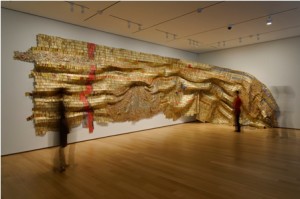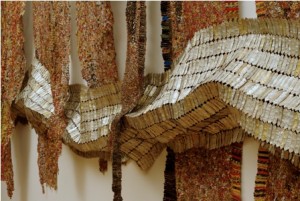 Reviewed by Lesley Ann Beck
Reviewed by Lesley Ann Beck
[WILLIAMSTOWN, Mass.] – Three extraordinary sculptures by celebrated African artist El Anatsui are on view at the Sterling and Francine Clark Art Institute, in two galleries in the Stone Hill Center, through October 16. Pissarro’s People, a major exhibition of works by Impressionist master Camille Pissarro and Spaces: Photographs by Candida Höfer and Thomas Struth are also on view at the Clark this summer.
The sculptures by El Anatsui resemble enormous fluid tapestries, draped and pleated against the gallery walls, but they are not textiles at all; rather, they are made of small pieces of aluminum, cut from discarded bottle caps and linked together with tiny twists of copper wire.
The sculptures are of exceptional beauty, made up of swaths of articulated matte aluminum fragments in brass or silver punctuated with strips or clusters of rich reds, yellows, and blues.
 The aluminum pieces come from liquor containers, so some are embossed with brand names, many show the matte silver or gold that is the inner surface; and it is the outer surfaces that have the printed colors. It’s alchemy of a sort, to take such mundane, discarded material and turn it into artwork of power and presence. That such lovely works can be fashioned from trash is a testament to the vision of the artist.
The aluminum pieces come from liquor containers, so some are embossed with brand names, many show the matte silver or gold that is the inner surface; and it is the outer surfaces that have the printed colors. It’s alchemy of a sort, to take such mundane, discarded material and turn it into artwork of power and presence. That such lovely works can be fashioned from trash is a testament to the vision of the artist.
Intermittent Signals (2009), at 11 by 35 feet, is the largest piece on view in the Stone Hill Center; between the immense size of the piece and the richness of the surfaces, the work is compelling, inviting closer perusal. It gleams gold in horizontal rows, broken by a red stripe. Photography does not do these pieces justice; there is power in being in the room with these works.
 Strips of Earth’s Skin (2008), stretches 10 by 22 feet, with seven irregular drapes cascading over a wide horizontal swath of silvery metal. This piece has an ethereal quality, with some sections made of thousands of tiny twisted octagons of aluminum, casting intriguing shadows on the wall behind.
Strips of Earth’s Skin (2008), stretches 10 by 22 feet, with seven irregular drapes cascading over a wide horizontal swath of silvery metal. This piece has an ethereal quality, with some sections made of thousands of tiny twisted octagons of aluminum, casting intriguing shadows on the wall behind.
Delta (2010), at 11 by 11 feet, is being shown in a museum for the first time. The artist uses the darker segments of aluminum, black or dark blue, to incorporate stripes, reminiscent of paths, tracks, or rivers, into the fabric of the piece, adding to the composition as well as the narrative quality.
Anatsui gives freedom to the curators who install his artworks at each venue, so the sculptures look different every time they are displayed. Because the pieces are flexible, they can be draped, pleated, maniupulated and hung in various ways.
 El Anatsui was born in Ghana and lives in Nigeria; his work has been widely exhibited for more than thirty years, including participation in Africa Remix, an exhibition presented internationally from 2004 to 2007; the Venice Biennale in 2007; and Who Knows Tomorrow at Berlin’s Nationalgalerie in 2010.
El Anatsui was born in Ghana and lives in Nigeria; his work has been widely exhibited for more than thirty years, including participation in Africa Remix, an exhibition presented internationally from 2004 to 2007; the Venice Biennale in 2007; and Who Knows Tomorrow at Berlin’s Nationalgalerie in 2010.
El Anatsui started to create work with the aluminum when he found a bag of liquor bottle tops near his studio. The material represents the complex historical links between Africa and Europe; liquor, brought to Africa by Europeans, became a kind of currency. The scrap metal appealed to the artist in that it is a colorful, malleable material, as well as being a way to tell a story about how the presence of Europeans has had an effect on African history.
On July 24, curator and filmmaker Susan Vogel will present her documentary film, Fold Crumple Crush: The Art of El Anatsui with a talk about the making of the film, which follows the artist for three years and gives an insider’s view of the artist’s practice and techniques. A Ghanaian storyteller will present weekly tales on the balcony of Stone Hill Center.
The Clark is at 225 South St. in Williamstown, Mass. The galleries are open Tuesday through Sunday, 10 a.m. to 5 p.m. (daily in July and August). Admission is $15; free for children 18 and younger, members, and students with valid ID. For more information, call 413 458 2303 or visit clarkart.edu.
